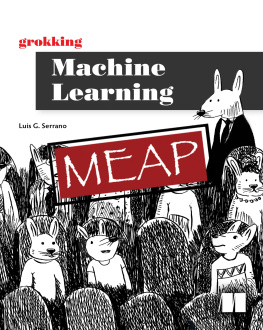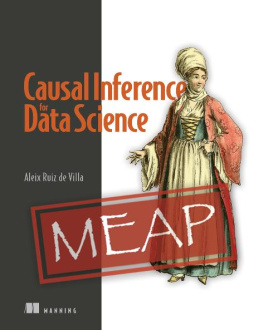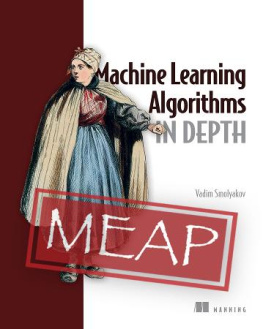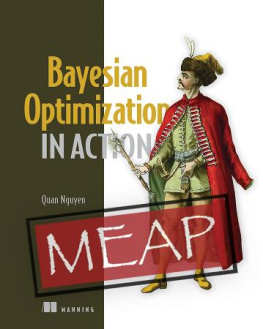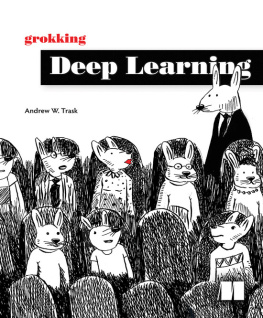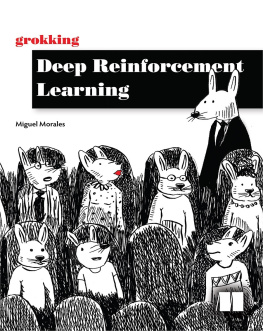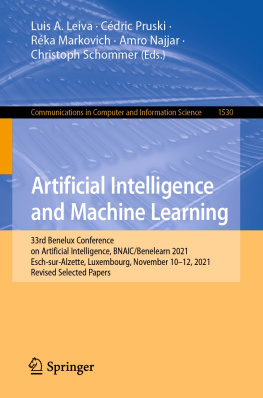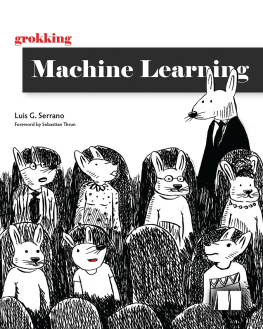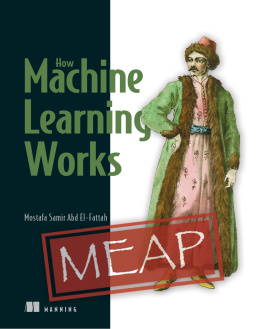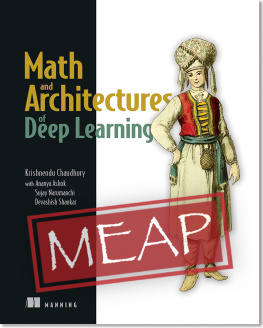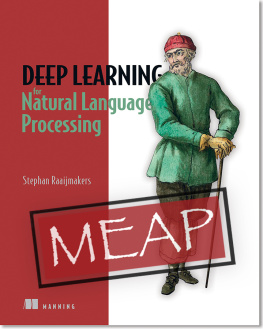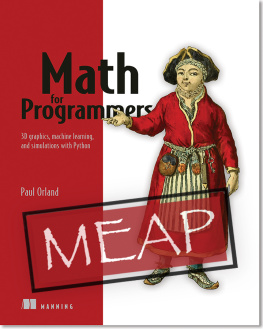Luis G. Serrano - Grokking Machine Learning MEAP V07
Here you can read online Luis G. Serrano - Grokking Machine Learning MEAP V07 full text of the book (entire story) in english for free. Download pdf and epub, get meaning, cover and reviews about this ebook. year: 2020, publisher: Manning Publications Co., genre: Children. Description of the work, (preface) as well as reviews are available. Best literature library LitArk.com created for fans of good reading and offers a wide selection of genres:
Romance novel
Science fiction
Adventure
Detective
Science
History
Home and family
Prose
Art
Politics
Computer
Non-fiction
Religion
Business
Children
Humor
Choose a favorite category and find really read worthwhile books. Enjoy immersion in the world of imagination, feel the emotions of the characters or learn something new for yourself, make an fascinating discovery.
- Book:Grokking Machine Learning MEAP V07
- Author:
- Publisher:Manning Publications Co.
- Genre:
- Year:2020
- Rating:4 / 5
- Favourites:Add to favourites
- Your mark:
- 80
- 1
- 2
- 3
- 4
- 5
Grokking Machine Learning MEAP V07: summary, description and annotation
We offer to read an annotation, description, summary or preface (depends on what the author of the book "Grokking Machine Learning MEAP V07" wrote himself). If you haven't found the necessary information about the book — write in the comments, we will try to find it.
Grokking Machine Learning MEAP V07 — read online for free the complete book (whole text) full work
Below is the text of the book, divided by pages. System saving the place of the last page read, allows you to conveniently read the book "Grokking Machine Learning MEAP V07" online for free, without having to search again every time where you left off. Put a bookmark, and you can go to the page where you finished reading at any time.
Font size:
Interval:
Bookmark:

MEAP Edition
Manning Early Access Program
Grokking Machine Learning
Version 7
For more information on this and other Manning titles go to
manning.com
Thank you for purchasing the MEAP edition of Grokking Machine Learning.
Machine learning is, without a doubt, one of the hottest topics in the world right now. Most companies are using it, or planning to use it, for many applications. Some people dub machine learning as the new electricity, or the new industrial revolution. I would go a bit farther and call it the new renaissance. Why? Because in the Renaissance, progress was made in the arts, the sciences, engineering, mathematics, and almost all the fields by the same people. With machine learning, this is finally possible again. With a strong knowledge of machine learning, one is able to derive cutting edge results in almost any field one decides to apply them, and this is fascinating. And that is what this book is for, to get you up to speed with the fast-moving world of machine learning!
But what is machine learning? I define it as common sense, but for a computer. What does this mean? It means that machine learning is the practice of getting computers to make decisions using the decision-making process that we, humans, utilize in our daily life. Humans make many decisions based on past experiences, and we can teach this decision- making process to the computer, with the difference that computers call their past experiences data.
Most approaches to machine learning require a heavy amount of mathematics, in particular, linear algebra, calculus, and probability. While a solid understanding of these topics is very useful for learning machine learning, I strongly believe that they are not absolutely necessary. What is needed to understand machine learning is a visual mind, an intuition of basic probability, and a strong desire to learn.
In this book, I present machine learning as a series of exercises of increasing difficulty, in which the final goal is to teach a computer how to take a particular decision. Each chapter is dedicated to a different machine learning algorithm, and is focused in one use-case of this algorithm, such as spam detection, language analysis, image recognition, and so on. For the readers who are interested in programming, I also code the algorithms in Python, and teach some useful packages that are used in industry and research. The code is also shared in Github for easy download.
I really hope that you enjoy this book, and that it is a first step on your journey toward becoming a machine learning expert!
I encourage you to share questions, comments, or suggestions about this book in liveBook's Discussion Forum for the book.
Luis Serrano, PhD
It is common sense, except done by a computer
This chapter covers:
What is machine learning?
Is machine learning hard? (Spoiler: No)
Why you should read this book?
What will we learn in this book?
How do humans think, how do machines think, and what does this have to do with machine learning?
I am super happy to join you in your learning journey!
Welcome to this book! Im super happy to be joining you in this journey through understanding machine learning. At a high level, machine learning is a process in which the computer solves problems and makes decisions in a similar way that humans do.
In this book, I want to bring one message to you, and it is: Machine learning is easy! You do not need to have a heavy math knowledge or a heavy programming background to understand it. What you need is common sense, a good visual intuition, and a desire to learn and to apply these methods to anything that you are passionate about and where you want to make an improvement in the world. Ive had an absolute blast writing this book, as I love understanding these topics more and more, and I hope you have a blast reading it and diving deep into machine learning!
Machine learning is everywhere, and you can do it.
Machine learning is everywhere. This statement seems to be more true every day. I have a hard time imagining a single aspect of life that cannot be improved in some way or another by machine learning. Anywhere there is a job that requires repetition, that requires looking at data and gathering conclusions, machine learning can help. Especially in the last few years, where computing power has grown so fast, and where data is gathered and processed pretty much anywhere. Just to name a few applications of machine learning: recommendation systems, image recognition, text processing, self-driving cars, spam recognition, anything. Maybe you have a goal or an area in which you are making, or want to make an impact on. Very likely, machine learning can be applied to this field, and hopefully that brought you to this book. So, lets find out together!
We play the music of machine learning; the formulas and code come later.
Most of the times, when I read a machine learning book or attend a machine learning lecture, I see either a sea of complicated formulas, or a sea of lines of code. For a long time, I thought this was machine learning, and it was only reserved for those who had a very solid knowledge of both.
I try to compare machine learning with other subjects, such as music. Musical theory and practice are complicated subjects. But when we think of music, we do not think of scores and scales, we think of songs and melodies. And then I wondered, is machine learning the same? Is it really just a bunch of formulas and code, or is there a melody behind that?
With this in mind, I embarked in a journey for understanding the melody of machine learning. I stared at formulas and code for months, drew many diagrams, scribbled drawings on napkins with my family, friends, and colleagues, trained models on small and large datasets, experimented, until finally some very pretty mental pictures started appearing. But it doesnt have to be that hard for you. You can learn more easily without having to deal with the math from the start. Especially since the increasing sophistication of ML tools removes much of the math burden. My goal with this book is to make machine learning fully understandable to every human, and this book is a step on that journey, that Im very happy youre taking with me!

Figure 1.1. Music is not only about scales and notes. There is a melody behind all the technicalities.
In the same way, machine learning is not about formulas and code.
There is also a melody, and in this book we sing it.
No.
Machine learning requires imagination, creativity, and a visual mind. This is all. It helps a lot if we know mathematics, but the formulas are not required. It helps if we know how to code, but nowadays, there are many packages and tools that help us use machine learning with minimal coding. Each day, machine learning is more available to everyone in the world. All you need is an idea of how to apply it to something, and some knowledge about how to handle data. The goal of this book is to give you this knowledge.
Once upon a time, if we wanted to make a computer perform a task, we had to write a program, namely, a whole set of instructions for the computer to follow. This is good for simple tasks, but how do we get a computer to, for example, identify what is on an image? For example, is there a car on it, is there a person on it. For these kind of tasks, all we can do is give the computer lots of images, and make it learn attributes about them, that will help it recognize them. This is machine learning, it is teaching computers how to to something by experience, rather than by instructions. It is the equivalent of when, as humans, we take decisions based on our intuition, which is based on previous experience. In a way, machine learning is about teaching the computer how to think like a human. Here is how I define machine learning in the most concise way:
Next pageFont size:
Interval:
Bookmark:
Similar books «Grokking Machine Learning MEAP V07»
Look at similar books to Grokking Machine Learning MEAP V07. We have selected literature similar in name and meaning in the hope of providing readers with more options to find new, interesting, not yet read works.
Discussion, reviews of the book Grokking Machine Learning MEAP V07 and just readers' own opinions. Leave your comments, write what you think about the work, its meaning or the main characters. Specify what exactly you liked and what you didn't like, and why you think so.

